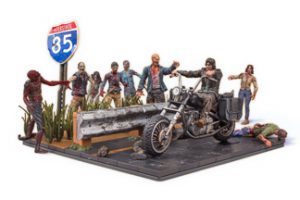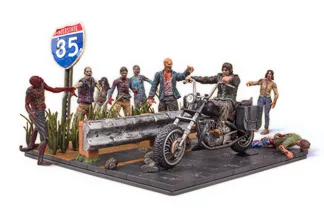This article was originally published in the July/August 2014 issue of The Toy Book. To read the entire digital issue, click here.
The construction play pattern has always allowed kids to create buildable worlds and adventures straight from their imaginations. But with a recent surge of licensed toys entering the category, kids are able to build more and more familiar worlds based on their favorite existing properties. According to The NPD Group, dollar sales of licensed building sets grew by 6 percent from 2011 to 2013. As the world becomes more multi-media driven, licensed properties are deeply integrated into kids’ daily lives. Established building toy companies, as well as those looking to get their feet wet in the category, are jumping on the bandwagon with characters and environments that are already a staple among kids—and even collectors.
A Buildable Debut
 This fall, McFarlane Toys will enter the construction category with a licensed building toy line based on AMC’s series, The Walking Dead. Todd McFarlane, founder of McFarlane Toys, is adamant on creating something that the construction aisle is missing.
This fall, McFarlane Toys will enter the construction category with a licensed building toy line based on AMC’s series, The Walking Dead. Todd McFarlane, founder of McFarlane Toys, is adamant on creating something that the construction aisle is missing.
“Twenty years ago I walked down the action figure aisle and I asked a simple question, ‘I don’t get why it can’t look cooler. It’s only plastic,’” says McFarlane. “I’m asking and answering the exact same question now in a new aisle. And the answer is: It can.”
Although McFarlane Toys is out of its comfort zone in this category (usually it focuses on action figures, collectibles, and novelty toys), McFarlane says that the company is taking this step confidently. The company designed The Walking Dead construction products with blocks that are compatible with other construction bricks on the market, but with detailed skins covering them. The result is finished products that don’t look like brick constructions—they look like items you could display on the shelf, which is great for the older demographic that makes up The Walking Dead’s viewing audience. As far as making his construction aisle debut with a licensed property instead of a proprietary one, McFarlane says this may prove to be an easier entrance.
“For a small company, it’s a huge benefit,” he says. “If you go in with an unknown [brand], then you have to educate the public on what it is—and now you have a big marketing spend. With a big brand name, you’re already halfway there.”
The Bridge Direct has also entered the construction aisle with licensed C3 sets based on WWE and the NBA. “There are advantages to launching with both licensed and non-licensed products. It just comes down to the concept, the fit, and the appeal,” says Dan Meyer, marketing director, The Bridge Direct.
The C3 NBA product line will launch this fall, while the C3 WWE StackDown line is already on shelves. The Bridge Direct focused on building a licensed toy line that was true to its concept, as well as a good fit for the company. WWE provided not only an audience of young boys—the typical demographic in the construction aisle as well—but also a whole new audience.
“WWE was one of the few remaining boys’ properties that had not yet ventured into construction—and that was exciting to us,” says Meyer. “Construction toys have the ability to reach a broad range of consumers—from kids to collectors to adults. The WWE brand also has this same holistic appeal. It was a natural fit.”
A Match Made in Licensing
There are many things that companies should take into consideration when trying to choose a licensed property on which to base a construction line.
“One of the most important things about license selection is its global nature. Mega Bloks is a global company and wants licenses with global appeal, so franchise popularity and differentiation are important,” says Adrian Roche, vice president, boys and collectors, global licensing at Mega Brands.
Construction provides a great play pattern for licensed toys. It allows kids and collectors to rebuild their favorite worlds, then provides the tools for a role-play play pattern after the set is built.
“It’s really critical that a property will translate well into the construction play pattern—not all of them do,” says Michael McNally, senior director, brand relations for Lego Systems. Properties that translate well into the construction play pattern are usually based heavily on stories, characters, and themes that can be recreated through buildable worlds.
“So much of what children expect today revolves around storytelling and characters, Licensing can provide some of the most popular characters and stories as inspiration for building and role play with the added value of, in many cases, an accompanying audience of fans who are potential collectors or consumers,” says McNally.
Developing a Licensed Set
Creating a licensed construction set is far different from a proprietary brand, due to the fact that the world in which the property exists is already established and well-known among its fanbase. This is important for companies to remember as they embark on the development stages of their new lines.
“Characters of the licenses are our first focus,” says Mega Bloks’ Roche. “It is essential for us to transform these iconic characters into authentic and poseable micro action figures. The feature-focused design enhances the opportunities for post-build play patterns, which is what really makes it come together as a great building toy.”
Beyond just staying true to an existing property, the company must also put its own spin on the product, so that differentiation helps to drive sales. The aforementioned McFarlane Toys created a whole new feel with the skins on its The Walking Dead-based construction line. Spin Master’s new Ionix line, which features shapeshifting bricks for a new kind of post-build play, adds a new twist on traditional building.
“We’re intimately involved in developing our construction sets with a high level of detail to stay true to the integrity of the characters and the world,” says Rob Wolf, senior brand manager, marketing for Spin Master. “With Ionix in particular, we’ve been able to integrate a truly new concept of shapeshifting bricks into the sets themselves and provide all new, creative ways to play and build the sets.”
Creating a construction set is a balance between accurately representing the property, creating innovations, and still remaining true to the licensee’s core values. It’s important for licensees to work with products that fit into what they are trying to achieve as a company, and for licensors to find a toy company that believes in what it is doing as a brand—and can integrate that into the innovations they are making in the toy industry. K’NEX, headquartered in Pennsylvania, believes that its company-wide dedication to products made in the U.S. is a big appeal to licensors.
“A little more than 80 percent of everything we produce is now made in the U.S.,” says Michael Araten, K’NEX’s president and CEO. “That’s unique in the category and that includes the licensed products. It’s something we’re seeing parents really clamoring for. It’s something that we’ve found, as we’re talking to licensors, is appealing to them.”
Companies also must take into consideration the core audience of the brand that they are developing into a toy. For example, when K’NEX creates new Plants vs. Zombies-themed toys, they focus on the core age demographic for that property: kids ages 5 to 10.
“One of our top priorities when developing a licensed set is the core age demographic that we’re designing the toys for so that we make the build buildable for all the kids in that age range,” says Araten.
While building sets provide tons of open-ended, imaginative play for all ages, sometimes kids—and collectors—look to re-create existing worlds that they know and love. Through licensed products, builders can create highly detailed, beautifully crafted environments and either re-enact their favorite storylines or create new adventures. Licensed construction toys give kids the ability to create and recreate the worlds they are already immersed in on a daily basis, further deepening the connection between the brand and its audience.

